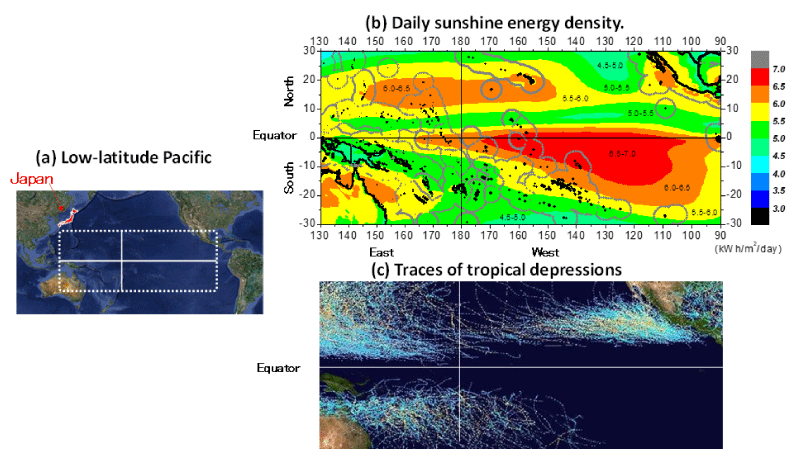Annals of Marine Science
Sailing mega-solar rafts for huge renewable energy in the low-latitude Pacific Ocean
Takaji Kokusho*
Cite this as
Kokusho T (2023) Sailing mega-solar rafts for huge renewable energy in the low-latitude Pacific Ocean. Ann Mar Sci 7(1): 017-020. DOI: 10.17352/ams.000033Copyright License
©2023 Kokusho T. This is an open-access article distributed under the terms of the Creative Commons Attribution License, which permits unrestricted use, distribution, and reproduction in any medium, provided the original author and source are credited.An innovative idea of exploiting huge solar energy in the low-latitude Pacific Ocean using wind-sailing mega-solar rafts is reviewed to emphasize its great potential for human renewable energy resources besides currently promoted offshore wind energy. The basic technologies including energy-transportation are already available but necessary to be developed commercially viable. It will also promote the peaceful use of open seas in the Pacific Ocean for a truly sustainable world instead of military confrontations.
Introduction
A great many offshore wind farms have already been deployed in northern Europe, most of which are fixed-bottom types on shallow sea floors. A floating type for deeper seas is more suitable for a freer choice of deployment, wherein the wind turbine is mounted on a float moored and anchored to the sea floor. Not only North Europe but also many other countries in the world are looking forward to the floating type of wind power as promising next-generation renewable energy because larger sea areas with stronger winds may be able to be available for power generation.
However, in Asian countries like Japan and Taiwan where natural environments are more hostile with severe typhoons, high seismicity, and tsunami, considerable technical challenges will have to be overcome before the power system is realized as a major player. It seems too optimistic to believe that we can depend exclusively on offshore floating wind power all over the world to meet the huge demand for ocean renewable energy. Even in Europe where offshore wind power is predominantly focused on, a possible combination with offshore solar power is investigated recently [1,2]. Offshore solar energy suitable to our particular environments in medium or low latitudes has to be explored much more in East Asian countries.
In this respect, we have studied the potential of offshore PV-solar power per unit area in comparison to wind power based on officially published data on renewable energy resources. As the result, solar power can generate 87~132 GWh/km2/year, 3 to 4 times (as also confirmed by other literature [3]) more than 24.7~30.1 GWh/km2/year of wind power offshore Japan, and the gap tends to increase with decreasing latitude toward the equator.
The offshore PV-solar power, despite such a huge energy potential and almost unlimited operation area over the land-based one, has been considered to have a couple of shortcomings difficult to overcome. The major hurdle is developing lightweight, cost-efficient, and durable floats, quite different from conventional bulky steel floats. Each of the floats will be a frame structure essentially made from plastics (HDPE), equipped with sails, keels, and rudders. The most significant design concern of the floats will be the resistance against rough waves and high winds during storms. For that goal, they will be structured by circular pipes with high bending strength/deformability [4,5] to overcome high waves, and covered by solar modules which should be folded during harsh weather to be protected from heavy winds.
Sailing mega-solar raft in low-latitude Pacific as a smart solution
However, designing the rafts against devastating storms potentially expected offshore will be almost impossible within a reasonable economy. A smart solution for that would be the mobility of the raft system instead of anchoring at a fixed location, which enables not only evading harsh weather conditions but also choosing richer sunshine energy. Furthermore, the non-stop mobile raft has a great advantage over the fixed one because of its much smaller impact on marine life. A fleet including the gigantic raft is automatically positioned by GPS without anchoring in offshore deep seas and is always sailing around calm seas very slowly by winds and sea currents basically by utilizing long-term maritime weather forecast technology a few weeks ahead.
The author already proposed [4,5] such a renewable energy system as conceptually shown in Figure 1. The fleet including gigantic floating rafts with a total area of 25 km2 can generate the same amount of energy during the daytime as a 1 GW nuclear power station operating 24 hours. The best place on earth for this type of sail is the low-latitude open seas of the Pacific Ocean as indicated in Figure 2(a). In most of the ocean, the annual average of daily sunshine energy exceeds 6.0 kWh/m2, and among the highest can reach 6.5~7.0 kWh/m2 between the equator and 15° south as an area of the highest solar energy density on earth as depicted in Figure 2(b) [6].
Hence, the mobile rafts can pursue optimal sunshine depending on the seasons attaining 8.0 kWh/m2 (more than twice the average near Japan) by making energy-saving self-controlled sailing at slow speed. The wind condition is very favorable with an annually averaged wind speed of 3~7 m/s [6] considerably milder than in high-latitude seas and stable in wind directions. The waves are never rough, 1~2 m high [7] on average, unlike middle/high latitudes in all seasons.
As the greatest risk to this energy system, tropical depressions named typhoons, hurricanes, or cyclones can never be ignored. Nevertheless, two wide areas of low-latitude Pacific are free from the risk as indicated in Figure 2(c) [8]. One is overlapping with the highest sunshine density area mentioned above due to exceptionally low-temperature seawater originating from Antarctica. Another is within ≈± 5° along the equator where the tropical depressions cannot theoretically be born because the Coriolis Effect is not working there. In other areas, the risk tends to increase but is not as severe as in the middle latitude. Ever-advancing ocean meteorology will surely facilitate reliable predictions of tropical depressions in a few weeks ahead for early evacuations. As for one more natural disaster, a tsunami, the effect may not be critical to this energy system as long as it stays remote from shallow coastal areas.
Other challenges to overcome
In addition to designing the innovative rafts system, the solar modules, thin, flexible, and completely different from conventional silicone-type, have to be developed. The Perovskite type is becoming increasingly promising recently because of its rapid advance in efficiency and economy. The modules are installed on the top of the rafts and keep functional even in rough waves because of their flexibility and high tensile strength, unlike the conventional silicon rigid thick modules. The energy-conversion efficiency will be expected around 20% in near future, and low-cost manufacturing technology integrating sail-cloths will be developed. Solar modules covering the rafts in great numbers and the associated energy collection systems should be long-term durable in the salt-water environment. AI-based labor-saving technologies will be developed to monitor, maintain and repair a great number of solar modules and power collection lines.
How to transport the huge energy efficiently over long distances from the low-latitude Pacific is another formidable challenge where two options may be available: Option No.1 is to transform the generated electricity into hydrogen H2 -gas by water-electrolysis to be shuttled either in the form of liquefied hydrogen or other chemicals. Electrolysis is commonly used for this option, though an 18% energy loss is inevitable. Farther great energy loss of 25 to 30% occurs in the above-mentioned process of liquefaction or chemical reactions even if another huge loss in returning H2 to electricity again is not considered here. Option No.2 is to transport the electricity directly by using a myriad of EV batteries packaged in special racks to be recharged in the mega-solar fleet. This option has a great advantage over the former because the energy loss in the charge/discharge process is only around 10%, and would be easily implemented if all the EV batteries are standardized to be plugged into the racks.
Thus, after major technical issues to realize this energy system have been studied, the economy has been very crudely estimated in terms of allowable solar module price to be higher than the present market price but almost viable if subsidized as listed in Table 1 [9]. This cost is based on the energy transportation using H2-gas in Option No. 1 and would be lowered further if energy transportation by EV batteries is realized.
Furthermore, there is no doubt that the right of any country to make sailing in international open seas for commercial purposes, wherein renewable sunshine energy is exploited on purpose, is authenticated by the International Maritime Law. Hence it is needed as soon as possible to form a consensus in international forums such as IMO (International Maritime Organization) on how to establish such an unprecedented use of low-latitude open seas for huge solar power generation by paying enough attention to maritime environments and other human activities there. Thereby, an early announcement of the sailing route of the fleet to other sea traffics a few weeks ahead should be mandatory. Fortunately, the low-latitude Pacific open seas are remote from major commercial sea traffic concentrating in high latitudes.
Finally, one may wonder if such a green-energy initiative in the low-latitude Pacific Ocean may coexist with the current circumstances of the US-China power confrontation heating up right there. Because of that, however, it is really meaningful from a quite different perspective of world peace to start this very peaceful project in cooperation firstly with Pacific Island nations most threatened by global warming as well as with many other countries being interested.
Summary
- Wind-sailing mega-solar rafts can exploit huge PV-solar power in the low-latitude Pacific Ocean for human renewable energy resources, 3 to 4 times or even more than currently promoted offshore wind per unit sea area.
- The rafts will be always moving self-controlled by GPS in open seas slowly by winds and sea currents pursuing better weather and richer sunshine while giving the smallest impact on marine lives and the greatest attention to other sea traffics and neighboring islanders.
- The energy system is estimated to be almost feasible with the basic technologies already available including energy transportation and Perovskite solar modules, which have to be developed as commercially viable.
- This energy system is also meaningful from a geopolitical viewpoint to promote the peaceful use of open seas in the Pacific Ocean for a truly sustainable world instead of military confrontations.
- Ocean Sun pioneering floating solar power solutions. 2023, April 2. https://www.theexplorer.no/solutions/ocean-sun--pioneering-floating-solar-power-solutions/
- A world’s first: offshore floating solar farm installed at the Dutch North Sea. 2023, April 2. https://oceansofenergy.blue/2019/12/11/a-worlds-first-offshore-floating-solar-farm-installed-at-the-dutch-north-sea/
- Takagi K, Osawa H. A preliminary consideration on the expansion of ocean renewable energy in Japanese EEZ, Journal of the Japan Society of Naval Architects and Ocean Engineers (in Japanese). 2010; 12:143-148.
- Kokusho T. Realize 100% Renewable Energy in the Low-Latitude Pacific Ocean. 2023, April 2. https://kokasahi.com/koktak/realize-100-renewable-energy-in-low-latitude-pacific-ocean
- Kokusho T, Emoto E, Kato T. Sailing solar-cell raft project and weather and marine conditions in low-latitude Pacific Ocean, Journal of Energy Engineering, American Society for Civil Engineers. 2013; 139(1): 2-7.
- NASA. 22-year Monthly & Annual Average (July 1983 - June 2005)-NASA Surface meteorology and Solar Energy (SSE)- Release 6.0 Data Set. 2023, April 2. https://power.larc.nasa.gov/
- Watanabe I, Tomita H, Tanizawa K. Winds and waves in North Pacific Ocean 1974-1988. 2023, April 2. https://www.nmri.go.jp/service/repository_data/PNM19140001-00.pdf
- Worldwide map of all tropical cyclone tracks between 1985 and 2005. 2023, April 2. https://commons.wikimedia.org/wiki/File:Global_tropical_cyclone_tracks-edit2.jpg
- Kokusho T. Feasibility of Mega Solar Raft in Low-Latitude Pacific Ocean. Journal of JSES, Japan Sunshine Energy Society. 2016; 42(6): 49-57 (in Japanese).

Article Alerts
Subscribe to our articles alerts and stay tuned.
 This work is licensed under a Creative Commons Attribution 4.0 International License.
This work is licensed under a Creative Commons Attribution 4.0 International License.



 Save to Mendeley
Save to Mendeley
